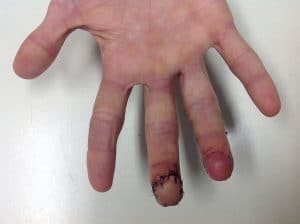The aim of scar management is not to just treat the scar but to PREVENT scarring. Scar management is essential in not only post-surgical management but also in trauma management and burn or split skin graft management.
It is essential to both reduce the pressure to the tissues as they are healing in order to prevent too much scar tissue and reduce the risk of it “sticking down”; and to move structures that are safe to move. This helps to ensure there is ‘glide’ of the tissues against each other and helps prevent everything sticking down together.
Scarring can cause problems such as sensitivity, numbness, colour changes and loss of movement. With any injury, the body goes through stages of repair. Collagen is the connective tissue that your body produces during this repair, which we refer to as scar tissue.
When collagen is initially laid down, it is not done uniformly and is not strong. Usually after 21 days the scar starts to increase strength. This is due to the changes in how the collagen is being formed and laid down.
As the scar heals it also contracts in, meaning it becomes tighter and closer together. With healing after an injury, surgery or a burn, scar tissue can involve bone, ligaments, joint capsule, tendons, muscle and skin.
Scar tissue forming is similar to if we upended glue into the area and it was left to set. If left still, all of these layers can stick together, which in the long term may mean a joint or area of skin can’t move, tendons can’t glide, ligaments, muscles or skin can’t glide or stretch. It can also affect how the fluid is transported around the area resulting in swelling. This can significantly impact range of movement.
The way your scar is treated will be customised to your needs so scarring is minimised.
Scar management options are tailored to each individual, each scar presentation, the age of the scar and the way in which the scar was sustained (eg trauma scarring, surgical scarring or burns/graft scarring).
Scar management treatment options include:
- Oedema management
- Compression bandaging or compression garments
- Topical treatment options such as scar taping or silicone taping, in addition to molds and scar massage.
Book your appointment online or contact us to find out more.


